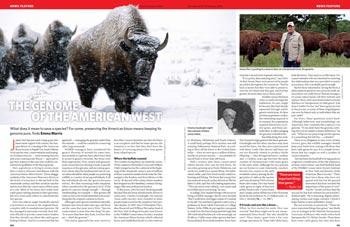
- Select a language for the TTS:
- UK English Female
- UK English Male
- US English Female
- US English Male
- Australian Female
- Australian Male
- Language selected: (auto detect) - EN
Play all audios:
What does it mean to save a species? For some, preserving the American bison means keeping its genome pure, finds Emma Marris. You have full access to this article via your institution.
Download PDF Download a PDF of this story. James Derr has just eaten a large grass-fed-bison steak topped with onions, the banquet dinner at a meeting of the American Bison Society in Rapid
City, South Dakota. As he sips his wine, conservationists and managers of nature reserves — some wearing Stetsons and some wearing polar fleeces — approach to pay their respects to the man
who could be considered the godfather of the bison genome. Derr, a geneticist, is trying to reverse more than a century of human interference with the American bison (_Bison bison_). Those
shaggy symbols of the American West were driven to the brink of extinction in the last half of the nineteenth century and then saved on ranches and in zoos. But the conservation efforts came
at a cost. Most of the bison alive today have cattle genes rattling around in their genomes, left over from early efforts to interbreed the two species. Derr has almost single-handedly
started a movement to preserve the original bison, complete with its unadulterated genome. He has managed to persuade everyone from federal officials to private conservation leaders that
they should care about the cattle genes hiding in bison. And he is convinced that his approach — managing the genome rather than the animals — could be a model for conserving other large
mammals. Wildlife managers have considered the genetic diversity of animals for some time, and animals in captivity have often been bred to preserve genetic diversity. But those were blunt
approaches. Now, armed with genomic tools, researchers are starting to look at specific sequences in the genome, and are raising questions about what the fundamental unit of conservation
should be. Most people see preserving wildlife as a matter of saving individuals; if all the individuals die out, the species becomes extinct. But that reasoning looks simplistic when
considered at the genomic level. If the genes of a species change enough — through interbreeding, for example — that species will cease to exist even if individuals that look something like
the original continue to thrive. > Species conservation is more than skin deep. James Derr Although some species interbreed naturally, humans have forced other mix-ups, and those are the
cases that most worry Derr. "Species conservation is more than skin deep," he says. "It is more than how they look, it is how they are — that's the genome." This
purist approach has won converts, but other conservationists say that the bison is an exception, and that for many species, the situation is so dire that they don't have the luxury of
worrying about a few stray genes from related species. WHERE THE BUFFALO ROAMED The troubles facing bison are relatively recent. When explorers Meriwether Lewis and William Clark voyaged
across the continent at the beginning of the nineteenth century, tens of millions of bison roamed in massive herds from the Mississippi to the Rockies, and from Mexico to the Arctic. By the
end of the century bison numbers had dropped to a few hundred, courtesy of long-range rifles and professional hunters. Charles Goodnight was a pioneer of bison conservation. Credit:
PANHANDLE-PLAINS HISTORICAL MUSEUM, CANYON, TEXAS At this point, a few forward-thinking people decided that the bison should not be driven to extinction. Charles Goodnight, the famous Texas
cattle rancher, and a handful of other people made room for the animal on their private ranches. In 1905, then US President Theodore Roosevelt and William Hornaday, head of the New York
Zoological Society (now known as the Wildlife Conservation Society), founded the American Bison Society, which collected bison and established herds in a few reserves in Montana, Oklahoma
and South Dakota. A small herd, perhaps 30 in number, was still roaming Yellowstone National Park. According to Derr, all the bison in the United States today — there are now up to a million
of them, mostly on private ranches — can probably be traced back to fewer than 200 bison. Half a century after those conservation efforts started, Derr saw his first bison. He was a boy,
growing up in Enid, Oklahoma, just north of a small town named Bison. His father raised cattle, and Derr lived mostly outdoors, hunting and fishing. The bison that young Derr encountered on
local ranches did not act like his father's cattle, and they left a lasting impression. "They are much more athletic, very smart and incredibly quick and strong," he says. In
college, Derr studied biology with an eye to being a wildlife manager. But he soon decided "that I could have a lot bigger impact if I worked in the lab". He switched to genetics
and is now a professor at Texas A&M University in College Station. In the 1990s, he put together a proposal to study how the bison had passed through that 200-individual bottleneck with
seemingly no ill effects. Unlike many other species that have bounced back from small numbers, bison have retained a decent level of genetic diversity. "It is a pretty darn amazing
story," says Derr. At their fewest, bison were preserved by people sprinkled throughout the continent. "Just by luck, it seems that they were able to preserve, with the few bison
that they got, much of the genetic diversity that was in those areas." James Derr is pushing to conserve bison at a fundamental level, the genome. Credit: L. WADSWORTH, TEXAS A&M
UNIV. Another reason the bison came so easily through the bottleneck, he says, might be because they had already squeezed through earlier genetic restrictions. In these previous population
crashes, the inbreeding required to re-expand the population exposed deleterious recessive genes, and those animals died, in effect purging the genome of lethal traits. But while doing this
work, Derr found foreign genes in the bison genome. Goodnight and the other ranchers may have saved the bison, but they also experimented with them. Cattle (_Bos taurus_) and bison are not
too distantly related to produce fertile offspring — they diverged between 1 million and 1.5 million years ago but have the same number of chromosomes, with many genes in the same order.
Although the two animals are not known to mate voluntarily, ranchers forced a few crosses in the early twentieth century, leaving the fingerprints of cattle on the nuclear and mitochondrial
DNA of most bison alive today. Derr has found cattle genes in eight of fourteen public herds in the United States and Canada, and in all but one of the 50 private herds he has looked at (N.
D. Halbert and J. N. Derr _J. Heredity_ 98, 1–12; 2007). IF IT LOOKS AND ACTS LIKE A BISON ... When he first started his work, Derr was worried "that there might not be any
uncontaminated bison herds". But why should he care? These bison, apart from a few very strange specimens in Texas with white faces, look like bison. They seem to act like bison. For
conservationists who are interested in restoring the relationships that once prevailed in prairie ecosystems, that is probably good enough. But for those interested in 'saving the
bison', a philosophical question now presents itself: are most bison not really bison? Should managers of conservation herds cull their hybrids and replace them with uncontaminated
animals that have no 'introgression' of cattle genes? And does it matter if some 'real' bison genes are lost in the process, as some of these original genes can now be
found only in individuals that are part cattle? For Derr, these questions aren't hard. Although behaviour and morphology are important, Derr contends that a species is its genome.
"If you don't have the genome, nothing else you do makes a damn difference," he says. "What you are preserving isn't the species; it is something the hell else — a
shadow." There is no obligation to save every version of every gene, but wildlife managers should keep pure herds from mixing with those that have cattle genes, he says. It is a simple
formulation that has caught on with a number of conservationists. "Jim has been the lead bull in bringing about a rigorous consideration of the role of genetics in bison
conservation," says Kent Redford, head of the Wildlife Conservation Society Institute in New York and director of the American Bison Society. "There have been those who have not
agreed with Jim but the general movement has been towards the importance of his point of view." And he "would not have had the success he has had without his personality",
Redford adds. "He is charming, slightly intimidating, tireless and single-minded. I think it helps that he is most definitely a Texan." > There are more important things than
genes. Rurik List But not everyone is convinced. "There are more important things than genes," says Rurik List, an ecologist at the National Autonomous University of Mexico, who
works with a herd that spans the US–Mexico border. These bison have some cattle genes, but they also have institutional memory. If List were to remove them and replace them with pure
animals, would the bison still be able to find the water holes that the current herd knows so well? "They have been behaving like bison for 80 years," says List. "They have
been fulfilling an ecological role." Greg Wilson of the Canadian Wildlife Service in Ontario agrees. "I am less adamant about the pure bison thing," he says. "Whether you
have 0% introgression or 2% introgression, it seems pretty arbitrary to me." Until now, Derr has used about 14 loci to look for cattle genes in bison herds — that is, 14 places in
which a certain pattern of base pairs will signify a cattle ancestor. The loci were narrowed down from 200 candidates in areas on the genome that have had a relatively brisk level of
mutation in mammals. Derr found short spans, each of about 100–200 base pairs, that gave a clear bison or cattle signal and that were far enough away from each other to constitute
independent observations. However, the function of genes that overlap with or are near to these loci is unknown. So far, the only established difference between bison with and without cattle
genes is their weight, a common indicator of the overall condition of an animal. According Derr's as yet unpublished work, 5-year old male bison with cattle mitochondrial DNA were on
average 4.5 kilograms lighter than those without. But with just 14 loci, Derr hasn't been able to say anything about individual animals. A bison with 1% cattle genes might have them in
places besides the 14 loci that Derr tests. Statistically, he needs a sizeable sample of animals — perhaps many dozens — to say for sure whether the herd has cattle genes in it. Now that the
domestic cattle genome has been sequenced, Derr is working on a 'SNP chip', a ready-made test to identify thousands of individual nucleotides that will be able to tell what
proportion of the bison genome is made up of cattle genes. All he needs to do to find these nucleotides is to compare the two genomes and see where the differences are. He says he needs
US$150,000 and a year and a half to make it work, and that each test will cost less than $75. When bison populations crashed, the New York Zoological Society and William Hornaday (right)
helped save the species. Credit: US FISH & WILDLIFE SERVICE; SMITHSONIAN INSTITUTION ARCHIVES Derr is a persuasive man. He has won over some government officials, but whether his efforts
will translate into policy changes is uncertain, especially as many of the decision-makers are likely to be replaced under the administration of President Barack Obama. Kaush Arha, the
former deputy assistant secretary for Fish and Wildlife and Parks at the Department of the Interior put together a bison working group that met with Derr and other scientists in October.
Arha predicts that policy will eventually enshrine Derr's thinking. Moving animals from a hybrid herd to a clean herd, for example, might become forbidden. Peter Dratch, a specialist in
endangered species at the National Park Service, agrees. "We are now in an era where we need to look at the genetics of species," he says. For the bison, he says,
"introductions to a herd should take place only when they do not increase overall levels of cattle ancestry". At the same time, small, pure herds that don't have enough
animals to have healthy gene pools should be moved around so as to keep the genes flowing. "We will probably have to artificially create immigration." DEFINING FEATURES Dratch even
floats the idea of differentiating between 'wild' bison and those that have been commercially bred, which might be better thought of as livestock. "A wild bison," he
says, "is a member of a herd of significant size with low levels of cattle or subspecies introgression that is subject to forces of natural selection — including predation, and
competition for forage and breeding opportunities." Such a definition might have implications for the Endangered Species Act, which is notoriously unclear about hybrids. If bison with
more than a certain proportion of cattle genes don't count as bison under the act, and if, as Derr suspects, only about 8,000 animals have no detectable cattle genes, then some bison
might even qualify as endangered. The American Prairie Foundation took Derr's ideas seriously when it went shopping for bison to place in its reserve in central Montana. So did the
Nature Conservancy when it came to stocking a preserve in Iowa. Both organizations chose bison from Wind Cave National Park in South Dakota. The Wind Cave herd is one of only two federally
owned herds that Derr is confident contain no cattle genes. To a visitor, the pure bison at Wind Cave seem remarkably tame. They will approach a stopped car to lick road salt off of its
undercarriage, and seem unperturbed by camera-wielding humans. It may be that when Derr's SNP chip is ready some cattle genes will be found in the animals at Wind Cave. After all, they
are separated only by a chain-link fence from bison known to have cattle genes. But if introgression levels are low, individual animals with cattle genes could be plucked out. Derr hopes
that conservationists will use the sequences from domestic animals to learn about the genomes of wild species that have chequered genetic pasts. Some hybrids have arisen for economic or
accidental reasons. For example, cattle have bred with the massive wild gaur (_Bos gaurus_) and Southeast Asian banteng (_Bos javanicus_). Others were created for conservation purposes:
birds such as the peregrine falcon, for instance, have been bred across subpopulations for reintroduction into the wild. With a toolbox of SNP chips, wildlife managers may be able to tease
apart mixed-up lineages and preserve pure genomes. Or such tests might show that it would be detrimental to try to weed out domestic genes from wild populations. But the genomic approach
goes beyond just working with hybrids. Looking at species as the sum of their genetic variation could help near-extinct populations. It could help managers to decide whether to bring two
isolated groups of the same species together to improve genetic variation or to keep them separate. Suddenly, the world's fauna stops looking like a bunch of animals, and seems more
like a group of genomes riding around in animal-shaped containers. Derr is working on a number of species' genomes, but has a special place in his heart for the bison. They symbolize
everything about the West, he says. "Bison are incredible survivors." Authors * Emma Marris View author publications You can also search for this author inPubMed Google Scholar
RELATED LINKS RELATED LINKS RELATED EXTERNAL LINKS Department of the Interior Bison Initiative American Bison Society National Bison Association James Derr RIGHTS AND PERMISSIONS Reprints
and permissions ABOUT THIS ARTICLE CITE THIS ARTICLE Marris, E. Conservation: The genome of the American West. _Nature_ 457, 950–952 (2009). https://doi.org/10.1038/457950a Download citation
* Published: 18 February 2009 * Issue Date: 19 February 2009 * DOI: https://doi.org/10.1038/457950a SHARE THIS ARTICLE Anyone you share the following link with will be able to read this
content: Get shareable link Sorry, a shareable link is not currently available for this article. Copy to clipboard Provided by the Springer Nature SharedIt content-sharing initiative







